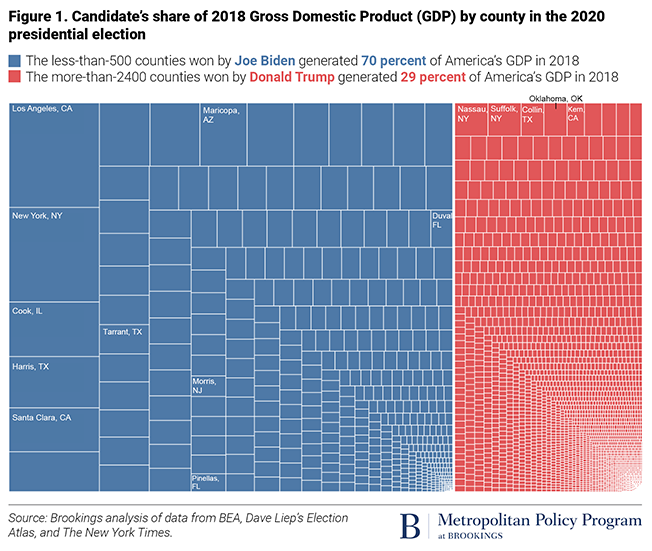On The Trail: Biden wins America’s economic engines
President-elect Joe Biden’s victory last week came on the strength of his performance in the strongest parts of America’s economy, the latest sign of a growing economic and cultural divide that’s increasingly shaping the nation’s political debate.
That chasm will make reconciliation between bitter partisans all the more difficult in the years ahead.
Biden carried only 477 of the 3,141 counties in the United States, but those counties account for 70 percent of the country’s economic output, according to new figures from the Metropolitan Policy Program at the Brookings Institution. The 2,497 counties that voted for President Trump account for just 29 percent of gross domestic product (GDP).

© Courtesy of the Brookings Institution
The partisan gap between the nation’s economic powerhouses and its laggards has widened dramatically over the last two decades. In 2000, Democratic nominee Al Gore won counties that made up 54 percent of the nation’s GDP; in 2016, the counties carried by Democratic nominee Hillary Clinton accounted for 64 percent of economic output.
This year, Biden added to Clinton’s totals by winning half of the 10 largest counties Trump carried in 2016: Arizona’s Maricopa County, which includes Phoenix; Texas’s Tarrant County, home of Fort Worth; Florida’s Duval and Pinellas counties, which cover Jacksonville and St. Petersburg, respectively; and New Jersey’s Morris County, a traditionally Republican suburb of New York City.
The growing Democratic advantage is a reflection of the evolution of an economy that was once based on agriculture and manufacturing but is now dominated by services and information.
Agriculture and manufacturing are becoming smaller sources of employment, in part because of growing efficiencies that require fewer workers. Information and services are becoming larger sources of jobs, positions that either require high levels of education or cannot be outsourced to a machine.
That shift has concentrated economic power in big cities and among younger, more diverse and better-educated workers — all groups that favor Democrats over Republicans.
“The economy benefits and expresses certain characteristics. The urban economy today is increasingly information-oriented, increasingly oriented towards services, including professional services, and therefore is dependent on talent, education and a relatively comfortable view of diversity and the future,” said Mark Muro, who directs policy at the Metropolitan Policy Program. “That is the economy that has been prevailing and concentrating in America’s cities in every state.”
More than a third of the residents in counties Biden won are both nonwhite (35 percent) and college-educated (36 percent). In counties Trump won, just 15 percent are nonwhite, and only a quarter have attained a college degree.
The changing geography of America’s economy and electorate is upending the political balance that both Democrats and Republicans have known for decades. Rural areas that were once the domain of labor unions representing blue-collar extractive workers are now solidly Republican. Suburban areas that were once the home of the country club Republican have now landed in the Democratic camp.
Morris County, the third-wealthiest county in the U.S., had not voted for a Democratic presidential candidate since Lyndon Johnson in 1964. Maricopa, home to both a growing Latino population and a new wave of younger workers looking for cheap housing and good jobs, had not voted for a Democrat since President Harry Truman in 1948.
In King County, Wash., home of Seattle, Trump won 21 percent of the vote in 2016 and 22 percent in 2020, the lowest share for any Republican presidential candidate since President William Howard Taft lost reelection in 1912. Trump won fewer raw votes this year than former President George H.W. Bush did in 1988.
Conversely, Trump carried Grays Harbor and Pacific counties in both his elections, the first Republican to carry them since President Herbert Hoover in 1928. Those former hubs of the Northwest timber industry were once solidly Democratic; former Massachusetts Gov. Michael Dukakis (D) took 60 percent of the vote in Grays Harbor in 1988 when he ran for president.
Those same patterns are showing up in pivot counties, counties that voted for President Obama twice and then Trump in 2016. In the 194 pivot counties where vote counts are complete, Trump held 174 this year, and by wider margins than four years ago.
The growing divide between the wealthier blue islands floating amidst a struggling sea of red is likely to exacerbate partisan disagreements in Washington, adding an economic component to the cultural wars that have gridlocked American politics.
Democrats are increasingly the party of big urban areas. Republicans are becoming the party of rural and small-town communities. With few exceptions left to act as bipartisan bridges, the representatives who must guide economic policy are torn by differing goals, driven by the jobs and industries that employ their constituents.
“They are informed by completely different economies, and when they go home to their districts or their home states, they are oriented towards different things,” Muro said. “The question is, can you run a competitive, successful economy when you have this kind of cross purposes. It’s not just a cultural disagreement, it’s an economic disagreement.”
On The Trail is a reported column by Reid Wilson, primarily focused on the 2020 elections.
Copyright 2023 Nexstar Media Inc. All rights reserved. This material may not be published, broadcast, rewritten, or redistributed. Regular the hill posts











